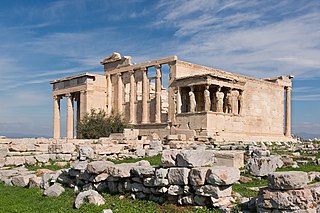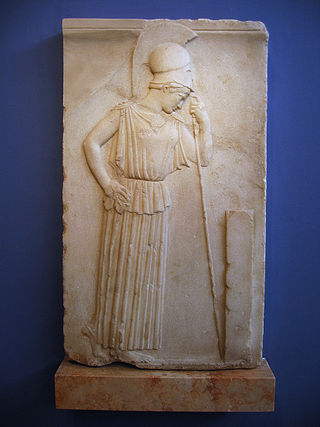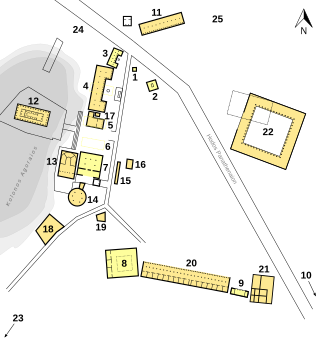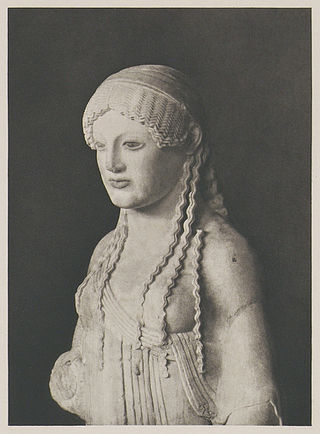
Eleusinion, also called the City Eleusinion was a sanctuary on the lower part of the north slope of the Acropolis in Athens, Greece, dedicated to Demeter and Kore (Persephone). It was the central hub of Eleusinian Mysteries within Athens and the starting point for the annual procession to Eleusis, in the northwest of Attica. Religious activity is attested in the area from the 7th century BC and construction took place throughout late Archaic, Classical, Hellenistic, and Roman periods. The sanctuary was enclosed within the new city walls built after the Herulian sack of Athens in AD 267 and it remained in use until the late fourth century AD.

Antenor was an Athenian sculptor. He is recorded as the creator of the joint statues of the tyrannicides Harmodius and Aristogeiton funded by the Athenians on the expulsion of Hippias. These statues were carried away to Susa by Xerxes I of Persia during the Greco-Persian Wars. Archaeologists have also established that a basis signed by "Antenor son of Eumares" belonged to a set of female figures in an archaic style which were displayed in the acropolis. The sculptor of the Harmodius and Aristogeiton is usually listed as the son of Euphranor.

The Erechtheion or Temple of Athena Polias is an ancient Greek Ionic temple on the north side of the Acropolis, Athens, which was primarily dedicated to the goddess Athena.

A peplos is a body-length garment established as typical attire for women in ancient Greece by c. 500 BC, during the late Archaic and Classical period. It was a long, rectangular cloth with the top edge folded down about halfway, so that what was the top of the rectangle was now draped below the waist, and the bottom of the rectangle was at the ankle. One side of the peplos could be left open, or pinned or sewn together. In Latin and in a Roman context, it could be called a palla.

Paeonius of Mende, Chalkidiki was a Greek sculptor of the late 5th century BC. He most likely received his early training in Northern Greece and is thought to have later adapted Athenian stylistic elements into his own work, based upon his probable interaction with the Olympia workshop of Phidias. In any case, he was "attic-trained."

The sculpture of ancient Greece is the main surviving type of fine ancient Greek art as, with the exception of painted ancient Greek pottery, almost no ancient Greek painting survives. Modern scholarship identifies three major stages in monumental sculpture in bronze and stone: the Archaic, Classical (480–323) and Hellenistic. At all periods there were great numbers of Greek terracotta figurines and small sculptures in metal and other materials.

The Perserschutt, as it is called in the German language, is the collection of ancient votive and architectural sculptures that belonged to the Acropolis of Athens before being destroyed during the second Persian invasion of Greece, which took place between 480 and 479 BCE. After defeating the Achaemenid Empire, the Greeks cleared and buried what was left of the Acropolis following the Persian destruction of Athens and subsequently rebuilt the city. A team of French, German, and Greek archaeologists discovered and excavated what would become known as the Perserschutt in the 19th century, and a number of the collection's artifacts are on display at the Acropolis Museum.

Neo-Attic or Atticizing is a sculptural style, beginning in Hellenistic sculpture and vase-painting of the 2nd century BC and climaxing in Roman art of the 2nd century AD, copying, adapting or closely following the style shown in reliefs and statues of the Classical and Archaic periods. It was first produced by a number of Neo-Attic workshops at Athens, which began to specialize in it, producing works for purchase by Roman connoisseurs, and was taken up in Rome, probably by Greek artisans.

The tetradrachm was a large silver coin that originated in Ancient Greece. It was nominally equivalent to four drachmae. Over time the tetradrachm effectively became the standard coin of the Antiquity, spreading well beyond the borders of the Greek World. As a result, tetradrachms were minted in vast quantities by various polities in many weight and fineness standards, though the Athens-derived Attic standard of about 17.2 grams was the most common.
Kore is the modern term given to a type of free-standing ancient Greek sculpture of the Archaic period depicting female figures, always of a young age. Kouroi are the youthful male equivalent of kore statues.

The Severe style, or Early Classical style, was the dominant idiom of Greek sculpture in the period ca. 490 to 450 BCE. It marks the breakdown of the canonical forms of archaic art and the transition to the greatly expanded vocabulary and expression of the classical moment of the late 5th century. It was an international style found at many cities in the Hellenic world and in a variety of media including: bronze sculpture in the round, stelae, and architectural relief. The style perhaps realized its greatest fulfillment in the metopes of the Temple of Zeus, Olympia.

The Temple of Apollo Patroos is a small ruined temple on the west side of the Ancient Agora of Athens. The original temple was an apsidal structure, built in the mid-sixth century BC and destroyed in 480/79 BC. The area probably remained sacred to Apollo. A new hexastyle ionic temple was built ca. 306-300 BC, which has an unusual L-shaped floor plan. Some fragments from the sculptural decoration of this structure survive. The colossal cult statue, by Euphranor, has also been recovered.

The following outline is provided as an overview of and topical guide to ancient Greece:
The Phrasikleia Kore is an Archaic Greek funerary statue by the artist Aristion of Paros, created between 550 and 540 BCE. It was found carefully buried in the ancient city of Myrrhinous in Attica and excavated in 1972. The exceptional preservation of the statue and the intact nature of the polychromy elements makes the Phrasikleia Kore one of the most important works of Archaic art.
The Peplos Kore is an ancient sculpture from the Acropolis of Athens. It is considered one of the best-known examples of Archaic Greek art. Kore is a type of archaic Greek statue that portrays a young woman with a stiff posture looking straight forward. Although this statue is one of the most famous examples of a kore, it is actually not considered a typical one. The statue is not completely straight, her face is leaned slightly to the side, and she is standing with her weight shifted to one leg. The other part of the statue's name, peplos, is based on the popular archaic Greek gown for women. When the statue was found it was initially thought that she was wearing a peplos, although it is now known that she is not.

The Antenor Kore is a Late Archaic statue of a girl (Kore) made of Parian marble, which was created around 530/20 BC.

The Kore of Lyons is a Greek statue of Pentelic marble depicting a bust of a young girl of the kore type, conserved at the musée des beaux-arts de Lyon, France. Deriving from the Athenian Acropolis, it is generally dated to the 540s BC. Considered the centrepiece of the museum's antiquities department, the statue was acquired between 1808 and 1810.

During the second Persian invasion of Greece, which took place between 480 and 479 BCE, Athens was captured and subsequently destroyed by the Achaemenid Empire. A prominent Greek city-state, it was attacked by the Persians in a two-phase offensive, amidst which the Persian king Xerxes the Great had issued an order calling for it to be torched. The Persian army commander Mardonius oversaw the razing of several structures of political and religious significance throughout the city, including the Acropolis, the Old Temple of Athena, and the Older Parthenon. A year later, the Greek coalition retook Athens and dealt a devastating defeat to the Persian army during the Battle of Plataea, killing Mardonius and setting the stage for the eventual expulsion of all Persian troops from Europe.

The Euthydikos Kore is a late archaic, Parian marble statue of the kore type, c 490–480 BCE, that once stood amongst the Akropolis votive sculptures. It was destroyed during the Persian invasion of 480 BCE and found in the Perserschutt. It is named after the dedication on the base of the sculpture, “Euthydikos son of Thaliarchos dedicated [me]”. It now stands in the Acropolis Museum.

Kore 670 is a Late Archaic Greek kore made of Parian marble, created in 520–510 BC, measuring 1.15 cm.






















